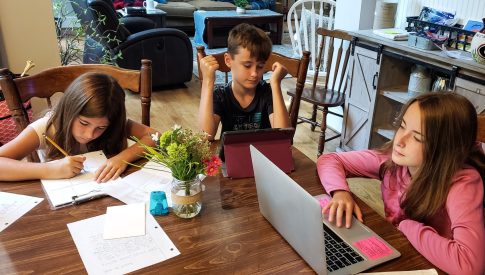Primary 7 - Second Level Literacy
Online Literacy Lessons for Primary 7 Students in Scotland.
Primary Seven grammar lessons begin with commas. We teach how to use commas in a list, to break up longer sentences and to use commas for parenthesis. Students learn how to separate list items using commas and include the word “and” before the last item. They will know they can use a comma before the connective, that they can add extra information to a sentence and separate the extra information using commas.
We introduce semi-colons, teaching how to use them to separate independent clauses and in a list. Students learn to state what semi-colons are used for, identify an independent clause and use semi-colons to separate two independent clauses. They learn to add semi-colons into a list and write a list using semi-colons.
We teach how to use brackets for parenthesis. Pupils learn to identify extra information within sentences and to add brackets to extra information within sentences. They will learn to identify an afterthought in a sentence, add brackets to an afterthought in a sentence and write sentences using brackets.
We introduce another set of homophones, 'where', 'were', 'we're' and 'wear' in sentences. Pupils learn to state the definition of each and choose the correct homophone in a sentence.
Our lessons show how to form plural nouns using plural rules. Pupils learn to state what a plural noun is and choose the correct plural ending to form plural nouns.
We teach how prefixes change the meaning of words. Pupils learn to identify prefixes in words and add prefixes to root words. They learn what a prefix is and does, the meaning of some prefixes and to recall words that include prefixes.
We teach how the suffixes '-less' and '-ful' change words and to add the suffixes '-less' and '-ful' to words. Pupils learn to state what a suffix is and how '-less' and '-ful' change the meaning of words. They learn to add '-less' and '-ful' to words and to words ending in y.
We further explore using apostrophes for possession. Pupils learn to state what apostrophes are used for, identify singular possessive and plural possessive nouns and add apostrophes to them.
We examine ambitious connectives in sentences. Pupils learn to state what a connective is, identify them and recognise then in sentences. They learn to use time connectives, comparing connectives, cause and effect connectives and adding connectives in sentences.
We teach how to use ambitious openers in sentences. Pupils learn to state what an opener is. They learn to use adverbs, similes, feelings and connectives as sentence openers.
We teach how to use possessive pronouns correctly in sentences. Pupils learn to state what a pronoun is. They learn to state what a possessive pronoun is, to identify possessive pronouns and exchange words for possessive pronouns.
Our Indirect Speech lesson teaches how to revise direct speech and understand and write direct speech. Pupils learn to state the difference between direct and indirect speech. They learn to write direct speech. They will be able to identify direct and indirect speech and convert direct into indirect speech and vice versa.
We teach how to use paragraphs properly. Pupils will be able to state what paragraphs are and why they are needed. They learn to explain and identify when a new paragraph is needed and add openers to paragraphs.
We teach how to write an effective character description. Pupils learn to identify effective language features in character descriptions. They learn to describe a character's appearance and traits. They learn to describe a character using similes and metaphors and two-adjective sentences.
We teach how to write an effective setting description. Pupils learn to identify effective language features in setting descriptions. They learn use their five senses to describe a setting and include similes, metaphors and two-adjective sentences.
We examine how students can improve pieces of writing by proofreading and editing. Pupils learn to proofread their writing for errors, identifying and improving missing or incorrect punctuation. They learn to identify and improve misspelled words, check that their writing makes sense and add to their writing to improve it.
Our reading lessons begin with predicting and visualisation. We teach how to use predicting to improve understanding of a text and to use visualisation to improve understanding of a text. Pupils learn to state what predicting is and when we make predictions. They learn
to make predictions using features of a test such as the front cover, blurb, etc.
They learn to make predictions by relating their own experiences to a text. They learn to state what visualisation is and use it to build a clear picture in their minds.
We explain how to identify and answer literal, inferential and evaluative questions. They learn to state what each type of question is and how to find the answer. They learn to identify literal, inferential and evaluative questions and answer them.
Learners are taught to summarise a piece of text. They learn able to state what summarising is and when to do it. They learn to read and understand a text, find the main ideas and events and paraphrase the main ideas and events.
We teach how to understand a text using skimming and to understand information in a text using scanning. They learn to state what skimming is and when to use it. They learn to list some strategies to help when skimming and skim a text for understanding.
They learn to state what scanning is and when to use it. They learn to list some strategies to help when scanning and be able to scan a text to find specific information.
We teach pupils to improve their understanding of unfamiliar words in text. They learn to state what an unfamiliar word is, scan a text and identify unfamiliar works and use various strategies to gain an understanding of unfamiliar words.
Our cloze procedure lessons help to complete cloze procedures. Pupils learn to state what a cloze procedure is, list some cloze procedure strategies and use various strategies to complete a cloze procedure.


"It's bright and colourful, easy to read, and extremely easy to use unlike most textbooks or online learning websites" Daisy, S3 PupilSign Up & Learn Today

